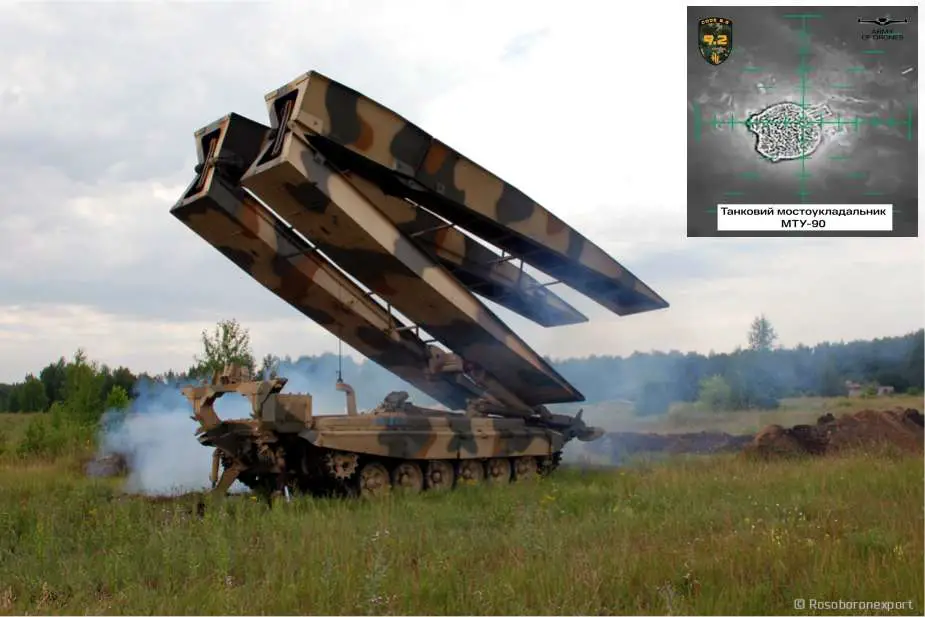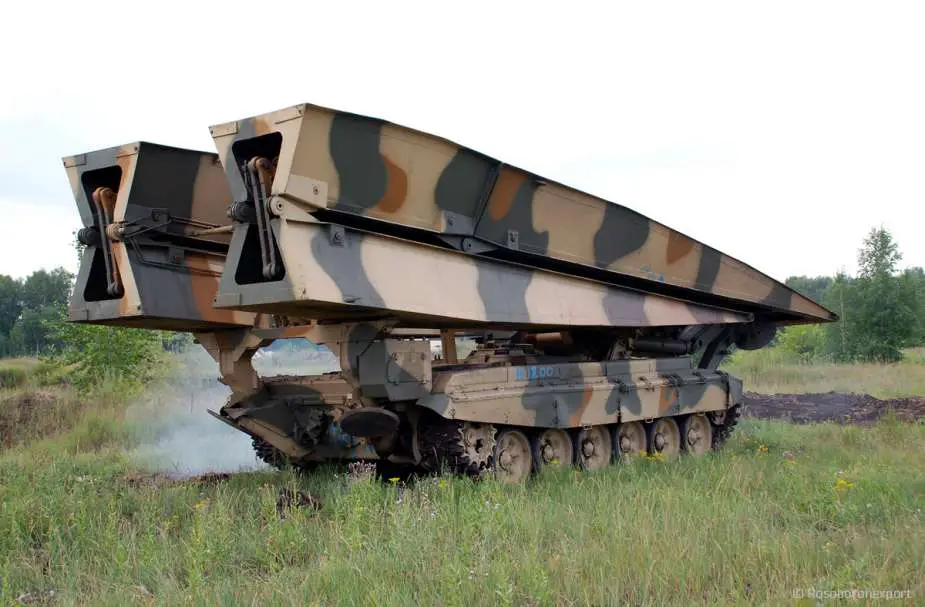- Army
- Conflicts in the world
- Israel - Iran conflict 2025
- Pakistan - India Conflict 2025
- Russia Ukraine War 2022
- Libya conflict day by day
- HAMAS - Israel War 2023
- Operation Serval in Mali French Army
- Sangaris operation Central African Republic
- Sangaris opération militaire République Centreafrique
- Ukraine - Russia conflict
- Syria conflict news
- Defence & Security Industry Technology
- Armies in the world
- Analysis Defense and Security Industry
- Conflicts in the world
- Navy
- Air
Ukrainian Forces destroy most advanced Russian MTU-90 armored bridge-layer vehicle
According to a Telegram video posted on August 31, 2023, Ukrainian Special Unit Code 9.2 orchestrated a night-time quadcopter drone attack near Bakhmut, resulting in the destruction of a T-80 tank, a 2S1 Gvozdika self-propelled howitzer, and a strategically significant MTU-90 armored bridge-builder, potentially in its latest variant MTU-90M. This development carries profound logistical implications for the region, as Russian military forces could heavily rely on the MTU-90 to facilitate the transportation of equipment across water obstacles.
Follow Army Recognition on Google News at this link

Ukrainian Forces destroyed a Russian MTU-90 armored bridge-layer vehicle (Picture source: Telegram and Rosoboronexport)
The MTU-90 Armoured Vehicle Launched Bridge (AVLB), based on a T-90 tank is a military engineering vehicle designed to bridge challenging terrains, including ditches, narrow rivers, and rugged landscapes. Originating from Russia, this vehicle boasts an array of noteworthy features and specifications. The MTU-90 has an improved variant, the MTU-90M based on the T-90S platform. The MTU-90M features a shorter bridge capable of spanning 19 meters while retaining its ability to carry loads of up to 60 tons. The Russian Army adopted the MTU-90M in 2013, and it has also been procured by other nations, including Azerbaijan.
Operated by a two-person crew, the MTU-90M carries a total weight of approximately 47.5 tons, with the bridge itself accounting for roughly 11.4 tons. Its standout feature is its lightning-fast bridge deployment capability, requiring a mere 2.5-3 minutes even under the most adverse conditions. Notably, the MTU-90M shares armor protection characteristics akin to the T-90S MBT, ensuring the safety of its crew. Moreover, it is equipped with an NBC protection system to enable operation in contaminated areas. With a bridge load capacity of up to 60 tons and a cruising range of 550 kilometers, it permits the movement of heavy military vehicles across challenging terrains.
Regarding its physical dimensions, the MTU-90M measures 9.6 meters in length, 3.55 meters in width, and 3.92 meters in height. The bridge it deploys spans an astonishing 25 meters, allowing it to bridge gaps of up to 23 meters.
The vehicle is powered by an 840-horsepower V-84MS diesel engine, propelling it to a top road speed of 60 km/h. Its maneuverability encompasses driving on gradients of up to 60%, side slopes of 40%, vertical steps of approximately 0.85 meters, trenches up to about 2.8 meters wide, and fording depths of roughly 1.2 meters. The MTU-90M AVLB can even cross water obstacles by submerging and driving underwater using a snorkel.
Typically, AVLBs are created by converting tracked tank chassis and repurposing them to carry a folding metal bridge in place of the tank's original weaponry. This conversion allows AVLBs to deploy a temporary bridge swiftly and efficiently. The bridges carried by AVLBs can vary in length, often exceeding 19 meters (60 feet), enabling them to span a wide range of obstacles and terrains.
The deployment procedure of an AVLB involves a systematic series of actions. When an obstacle is encountered, the AVLB unfolds and launches the bridge, positioning it securely across the obstacle in a matter of minutes. This deployment process is often automated or semi-automated to reduce crew exposure to enemy fire. Once the bridge is in place, the AVLB vehicle detaches from the bridge, allowing other military vehicles to cross. After all the vehicles have crossed the bridge, the AVLB itself crosses the bridge, re-attaches to it on the other side, and retracts the span for transportation to the next deployment location.

The MTU-90M Armoured Vehicle Launched Bridge (AVLB) is based on the T-90S tank (Picture source Rosoboronexport)
The origins of AVLBs can be traced back to World War I, particularly during the early stages of tank warfare. As tanks were developed, the challenge arose of maneuvering them across trench-laden battlefields. To address this, tanks were equipped with fascines, bundles of heavy sticks dropped into trenches to create paths for tank movement.
During World War II, AVLBs and other combat engineering and recovery vehicles gained prominence due to the emergence of Blitzkrieg warfare. This style of warfare required armored vehicles to advance alongside tanks, often outpacing infantry units. These vehicles needed to cross a variety of terrains without relying on a limited number of bridges.
Modern AVLBs are typically built on main battle tank (MBT) chassis to enhance mobility and ensure compatibility with tank units. Some AVLBs are equipped with amphibious capabilities, allowing them to act as a combination of pontoon and roadway vehicles for creating bridges over water.
The loss of an Armored Vehicle-Launched Bridge (AVLB) or any specialized military vehicle can have significant and wide-ranging consequences for troops and military operations. AVLBs are designed to provide rapid bridging solutions for military forces, enabling them to traverse obstacles quickly. Losing an AVLB can severely hinder mobility, making it difficult for troops and equipment to cross rivers, ditches, or other challenging terrain. This can lead to delays, alter operational plans, and limit the ability to react swiftly to changing situations on the battlefield.
The loss of an AVLB can disrupt ongoing operations. It may necessitate changes to the planned routes, the sequencing of units, or the timing of critical actions. Operational tempo can slow down, potentially impacting the element of surprise and overall mission success. Troops may find themselves with limited access to certain areas or objectives if they lose an AVLB. This can force them to seek alternative routes or wait for bridging equipment to arrive, potentially exposing them to enemy threats or causing mission objectives to be delayed or revised.
Losing an AVLB reduces the ability to quickly establish secure crossing points over obstacles. This increased vulnerability can expose military units to enemy attacks, ambushes, or counterattacks while they attempt to cross challenging terrain without the protection and cover provided by the AVLB. Resource Allocation: Replacing a lost AVLB can require a reallocation of valuable resources. This includes diverting time, manpower, and potentially scarce bridging equipment to procure or repair a replacement vehicle. Such resource shifts can strain logistics and disrupt other aspects of military planning and execution.
AVLBs often play a role in logistical support during military campaigns. Losing an AVLB can create logistical challenges, particularly in transporting supplies, equipment, and personnel across obstacles. Alternative logistical solutions may need to be devised, potentially slowing down the resupply process. Operational Delays: The absence of an AVLB can lead to operational delays, as it may take time to secure a replacement or repair the damaged vehicle. These delays can have a cascading effect on overall mission timelines and objectives.
In certain situations, the loss of an AVLB can have broader strategic implications. This is especially true if the AVLB is operating in a strategically critical area. Such losses may necessitate a reevaluation of overall military strategy and objectives.


























